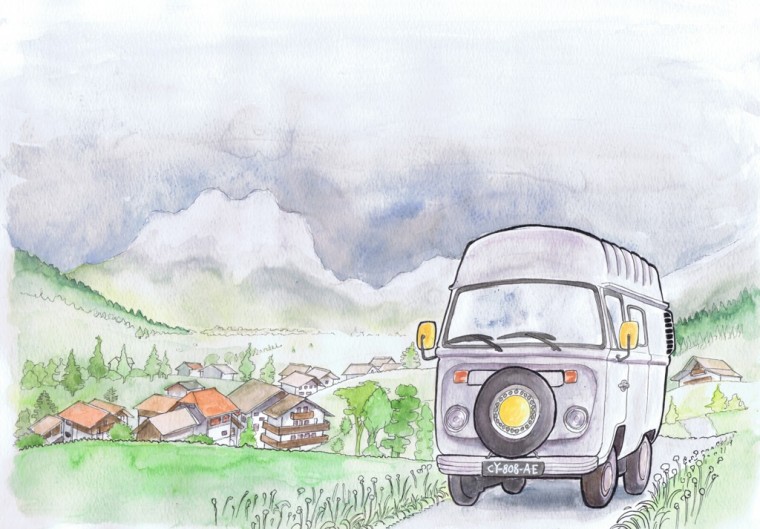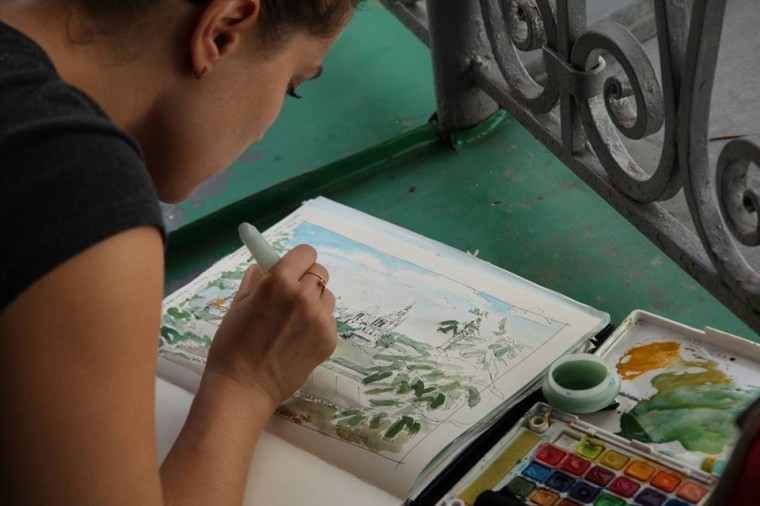Le Bulli sur le départ, à Strasbourg – Illustration Jonathan Bonnard
Après le départ du Bulli, le fameux combi VW, le samedi 10 mai depuis Strasbourg, Claire Audhuy et de Baptiste Cogitore ont pris le chemin de Trieste en traversant les Alpes. Le véhicule n’est pas rapide (60 km/h de moyenne), le voyage est long, les rencontres sont fortes.
Le Bulli en Autriche – Illustration Jonathan Bonnard
En effet, arrivés à Trieste, porte de l’Europe orientale, ville européenne et cosmopolite de la Méditerranée, Baptiste et Claire ont rencontré Boris Pahor, écrivain slovène, déporté au camp alsacien du Struthof pendant la Second Guerre mondiale. Celui évoque l’Europe d’hier, celle qui panse encore aujourd’hui les blessures de son lourd passé, dont il a été témoin, mais aussi celle de demain, portant un regard confiant sur la génération future. Il se dit citoyen du monde, soulignant la différence entre citoyenneté et nationalité, un débat souvent biaisé en France. Tatjana Rojc, spécialiste de la littérature italienne et slovène, s’intéressant notamment à Boris Pahor, a également souligné cette perspective cosmopolite de Trieste, bien au-delà des considérations nationales et apparaissant comme un port européen ouvert sur la Méditerranée. C’est aussi à Trieste qu’ils ont rencontré Ugo Pierri, peintre de Trieste, qui dessine le camp de concentration de la Riziera di San Sabba, en passant par l’allégorie pour rappeler ce fardeau douloureux.
Ugo Pierri et le camp de la Riziera di San Sabba – Illustration Jonathan Bonnard
Boris Pahor et le Grand canal de Trieste, ville cosmopolite de l’Europe méditerranéenne – Illustration Jonathan Bonnard
C’est ensuite en Slovénie, à Ljubljana, que le Combi a fait halte pour se pencher sur un théâtre un peu particulier : le théâtre des opprimés. Cette technique, importée du Brésil et qui a pris une certaine dimension en Europe, travaille sur les rapports de forces dans les relations sociales. Le but, tenter de les supprimer ou en tout cas de les diminuer. Depuis 2010, Barbara Polajnar développe plusieurs ateliers en Slovénie, elle explique ce théâtre nouveau dans l’interview réalisée par Claire Audhuy et Baptiste Cogitore.

Le Bulli en Slovénie – Illustration Jonathan Bonnard
En Croatie, Claire et Baptiste sont allés à la rencontre de la jeunesse de ce dernier Etat membre de l’Union européenne depuis juillet 2013. A Zagreb, Masa Filipovic, étudiante croate en médecine, s’interroge sur son pays et sur les élections européennes à venir. Sans illusion à propos du scrutin, elle voit son avenir autre part en Europe, peut être en Suède, découragée par le manque de perspective dans son pays, touché par le chômage des jeunes, et la corruption d’une partie de l’élite.
Le Bulli a repris la route et après une rencontre avec les victimes de la guerre à Vukovar, dans l’Est de la Croatie, Claire et Baptiste ont traversé les frontières de l’Union européenne pour rejoindre la ville de Novi Sad. Les inondations dans les Balkans ont ponctué le voyage, qui se poursuit à présent en Serbie.
Pendant ce temps, à Strasbourg, le jeudi 15 mai, aux Savons d’Hélène, l’équipe du Bulli Tour Europa et l’équipe de la Croisée des routes ont partagé avec quelques curieux le temps d’une soirée le film « I am Kombi » sur l’histoire du célèbre véhicule et sur le phénomène qu’il suscite à travers le monde. La présence de Claudia Marschal, la réalisatrice de ce long-métrage, a permis d’enrichir le débat autour du « phénomène Combi ».
Chronicle of week n°1: The cosmopolitan Europe of the Mediterranean
After the start of the Bulli, the famous Volkswagen Transporter, on the 10th of May from Strasbourg, Claire Audhuy and Baptiste Cogitore have taken the road leading to Trieste crossing the Alps. The vehicle is not fast (an average of 60 kilometers per hour), the journey is long, the encounters are poignant.
In fact, once in Trieste, the gate of Eastern Europe, the cosmopolitan and European city of the Mediterranean sea, Baptiste and Claire met Boris Pahor, a Slovenian writer, deported in the Alsatian camp of Struthof during World War II. He evokes the Europe of yesterday that he witnessed, the one that is still treating the wounds of its painful past, but also the Europe of tomorrow, with confidence for the future generation. He describes himself as a citizen of the world, underlining the difference between citizenship and nationality, an often biased discussion in France. Tatjana Rojc, specialist in Italian and Slovenian literature, who notably worked on Boris Pahor, has also underlined the cosmopolitan perspective of Trieste, going way further than the national considerations and looking like a European port opening on the Mediterranean sea. In Trieste they also met Ugo Pierri, a painter from Trieste, who depicts the concentration camp of the Riziera di San Sabba, using allegory to remind us of this distressing burden.
Then it is in Slovenia, in Ljubljana, that the Bulli stopped for a temporary stay to focus on a slightly peculiar theatre: the theatre of the oppressed. This technique, imported from Brazil has developed to a certain extent in Europe, it works on the balance of power in social relations. The aim is to try to erase or at least to diminish them. Since 2010, Barbara Polajnar has developed several working groups in Slovenia, she explains this new theatre in the interview led by Claire Audhuy and Baptiste Cogitore.
In Croatia, Claire and Baptiste got into the process of meeting the youth of this lastest member state of the European Union, that joined in July 2013. In Zagreb, Masa Filipovic, a Croatian who studies medicine, asks herself questions about her country and the European elections to come. She has no illusions about the elections, she does not picture herself living in this country, she sees her future somewhere else in Europe, maybe Sweden, discouraged by the lack of perspective in her country, affected by youth unemployment, and corruption among a part of the leaders.
The Bulli went on the road again to meet the victims of the war of Vukovar, eastern Croatia, Claire and Baptiste have crossed the borders of the European Union to get to the city of Novi Sad. The floods in the Balkans have punctuated our trip, that now carries on to Serbia.
In Strasbourg, on the 15th of May, at the Savons d’Hélène, the crew of the Bulli Tour and the crew of Croisées des Routes shared the film « I am Kombi » with some curious folks for an evening. The movie is about the history of the famous vehicle and the phenomenon it generated all around the world. The presence of Claudia Marschal, the director of this full-length movie, gave us the opportunity to enrich the discussion around the « Combi phenomenon ».
Chronik der ersten Woche: Das kosmopolitische Europa am Mittelmeer
Nach der Abfahrt des Bullis, dem berühmten VW-Kombi, am Samstag den 10. Mai von Straßburg aus, überquerten Claire Audhuy und Baptiste Cogitore die Alpen über Triest. Das Auto ist nicht sehr schnell (nur 60km/h im Durchschnitt), die Reise ist lang und die Begegnungen sind stark.
In Triest, dem Tor zum Orient und gleichzeitig kosmopolitische Großstadt, angekommen, trafen Baptiste und Claire auf Boris Pahor, einen slowenischen Autor, der während des zweiten Weltkriegs in das elsässische Konzentrationslager Struthof deportiert wurde.
Dieser ruft die Erinnerung an das Europa von gestern wach, weil er als Zeuge noch immer mit den schweren Wunden aus dieser Zeit zu kämpfen hat und dennoch zur gleichen Zeit zuversichtlich in Staatsbürgerschaft und Nationalität, gerade auch in Frankreich ist dies eine heiß geführte Debatte.
Tatjana Rojc, Spezialistin der italienischen und slowenischen Literatur, betont gleichwertig diese kosmopolitische Perspektive Triests, welches zum einen von großer nationaler Bedeutung ist und zum Anderen auch als Tor zum Mittelmeer fungiert.
In dieser Stadt haben sie auch Ugo Pierri, einen von dort stammenden Maler, getroffen, der das Konzentrationslager von Riziera di San Sabba zeichnet, um an diese schmerzliche Last zu erinnern.
In der Hauptstadt Sloweniens, Ljubljana, angekommen, macht der Bulli an einem ganz besonderen Theater halt: dem Theater der Unterdrückten. Diese Technik, ursprünglich aus Brasilien, hat sich in Europa inzwischen stark ausgedehnt und beruht auf der Balance der zwischenmenschlichen Beziehungen. Ziel ist es sie zu entfernen oder zumindest zu dezimieren.
Seit 2010 hat Barbara Polajnar eine Vielzahl dieser Arbeitsgruppen ins Leben gerufen und erklärt jenes neue Theater im Interview mit Claire Audhuy und Baptiste Cogitore.
In Kroatien treffen Claire und Baptiste dann auf die Jugend des, seit Juli 2013 und somit neuesten Mitgliedsstaats der Europäischen Union. In Zagreb, stellt sich Masa Filipovic, eine kroatische Medizinstudentin, den Fragen über ihr Land und die anstehenden Europawahlen. Sie hat hinsichtlich der Wahlen keine Illusionen, ihre Zukunft sieht sie nicht in diesem Land, sondern irgendwo anders in Europa, vielleicht in Schweden. Sie ist entmutigt von dem Mangel an Perspektiven, aufgrund der Jugendarbeitslosigkeit und Korruption bei einem Teil der Führungskräfte in ihrem Land.
Danach wagte sich der Bulli wieder auf die Straße, um die Opfer von Vukovar im Osten Kroatiens zu treffen. Claire und Baptiste überschreiten die Grenze der Europäischen Union, um nach Novi Sad zu kommen. Die Flut im Balkan hat die Reise geprägt und geht nun in Serbien weiter.
In Straßburg hingegen, haben die Bulli Anhänger und einige Neugierige im Savon d’Hélène am 15. Mai den Film „I am Kombi“ geschaut. Der Film handelt von der Geschichte dieses berühmten Fahrzeugs und dem Phänomen, das es auf der ganzen Welt mit sich bringt.Durch die Anwesenheit von Claudia Marschal, der Regisseurin des Films wurde die Diskussion um das „Bulli Phänomen“ nochmals bereichert.














